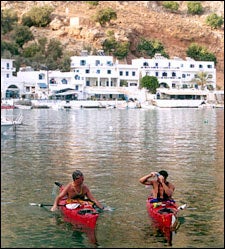“I am a philosopher,” says George Stavroulakis, a 64-year-old retired Greek sea captain. We are sitting over a plate of souvlaki and watching the sun set from a seaside restaurant in Hora Sfakion, Crete. “I like telling the young people what I know. You are a nice girl. Why don’t you marry a Greek man, have a family, and stay here?” After traveling the southern coast of Crete by kayak for the previous seven days, I am just about ready to drop everything and follow his advice. I haven’t found a man, but I’ve fallen in love with Crete’s dramatic coastline, delicious fresh food, hospitable people, and rich historical past.
European Meccas
Beyond the museums and the Brie, Europe is a wild continent packed with adventure hot spots. From Chamonix, France’s alpine-sports hub, to Girona, Spain’s cycling-mad town, .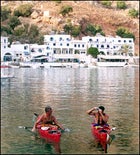 Northwest Passage guides Rick Sweitzer and Mike Agostinelli take a breather in Loutro’s port.
Northwest Passage guides Rick Sweitzer and Mike Agostinelli take a breather in Loutro’s port.
When the American outfitter The Northwest Passage invited me on their eight-day sea-kayaking trip, I had two reservations. I had kayaked only once before, and I hadn’t been on an organized trip since I was a thirteen-year-old summer camper. I imagined myself either fighting waves as I capsized a barely seaworthy vessel miles from shore or donning a yellow hat to follow a guide with a raised umbrella around a tourist-crammed site. The trip materialized, however, as the ultimate in what I never knew existed: posh adventure travel. I spent the days exhausting myself by cruising calm, turquoise-blue seas in a small red kayak, hiking rugged coastal mountains, and exploring sea caves, white sand beaches and Crete’s globally unrivalled bounty of hidden ruins—Roman, Minoan, Venetian, and Turkish. I spent the nights in tiny Mediterranean villages, eating savory moussaka, souvlaki and fresh feta cheese, being treated to nightly massages, and meeting the most hospitable people I could have imagined. Why go to Crete? With its calm, clear weather, drastically beautiful landscape, and dense history, a more apt question might be: Why go anywhere else?
Matala, Samaria Gorge, Agios Pavlos, and Marmara Beach
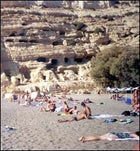 Sun worshippers lounge on Matala's protected beach, in front of caves used as ancient Roman tombs and Minoan storage cells.
Sun worshippers lounge on Matala's protected beach, in front of caves used as ancient Roman tombs and Minoan storage cells.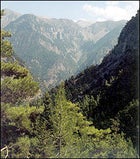 From the beginning of the trail in Xyloskalos, the Samaria Gorge drops 3,000 feet in less than two miles.
From the beginning of the trail in Xyloskalos, the Samaria Gorge drops 3,000 feet in less than two miles.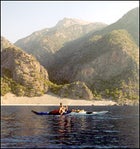 Cruising from Agia Roumeli to the beach at Agios Pavlos
Cruising from Agia Roumeli to the beach at Agios Pavlos
MATALA
The winds were gusting at 40 miles per hour and we stood warily on the beach watching white-capped waves crash about 300 yards from shore. “Wait, so do we actually have to go out in this?” said a fellow trip-mate. My stomach turned while I imagined myself capsizing and sinking in the chop. In a matter of hours, however, I graduated from the double to the single kayak and was ready for the safety procedure of intentionally capsizing and exiting the boat. Mike, the tanned, hunky 38-year-old co-leader of my trip, grabbed my paddle and pushed off from my boat. “See ya! Wouldn’t wanna be ya!” he yelled. I cringed but took a big gulp of air, plugged my nose and dove under the water. I was halfway out of the boat before it turned over and was breathing again in less than a second. “Is your fun-o-meter is spinning like crazy?” he asked, grinning. How could my fun-o-meter not be spinning? A handsome (and skilled) kayaker was watching over me, I had just done my first “wet exit,” I was paddling by ancient caves carved out for Roman tombs and gazing at a beautiful stretch of sandy umbrella-dotted beach.
After my first kayak session in Matala, I dined on a vegetarian pita at Cafe Nikos and then spotted a small sign pointing the way to Red Beach. From there, I set out on a 30-minute hike that took me past the ruins of an ancient Minoan port town and over a hill with a spectacular view. Red Beach could be mistaken for a seacoast version of Eden: beautiful tanned nude men and women walk down the shore with golden-haired toddlers in tow. The water is a translucent shade of turquoise, and in the summer and fall, endangered sea turtles congregate to nest and hatch their young.
Practical Info: Hotel Zafiria (phone: 011-30-28920-45112) offers beach-view rooms with balconies for $47. Pension Silvia (phone: 011-30-28920-45127), a small bougainvillea and geranium-covered hotel, is a little further from the beaten path and rents simple rooms from $29. Both hotels—and many others on the southern coast of Crete—are open only from April to October.
SAMARIA GORGE
“Man, I would love a big Amstel right now,” said Gordon, 45, a tall Canadian from the tour group who was my hiking partner for the day. “And a shower,” he added. “And a chair.” Amen to that, I thought, as we walked into the town of Agia Roumeli—my feet were numb from 10 miles of downhill pounding and a cold brew would’ve hit the spot, but I had to admit I was enjoying myself. We had walked through the Samaria Gorge, a pine- and cypress-filled fissure dotted with aquamarine pools of river water, and had hardly seen a single soul. Though the gorge is much loved by tourists, in the off-hours it retains a sense of undisturbed serenity. In fact, you can hardly munch a sesame-honey bar (the Greek version of a Powerbar) without a kri kri—a small, deer-like goat native to Crete—coming out of the trees to eye you. In 1962, the gorge was established as a national park to protect the overhunted kri kri and other rare wildlife, such as eagles, owls, vultures, and the Cretan polecat. In April and May the gorge teems with wildflowers, and at the end of it the ruins of two Turkish castles overlook the ocean, one easily reachable by a steep half-mile walk from the coastal village of Agia Roumeli.
Practical Info: No roads connect to Agia Roumeli at the bottom of the gorge and the last ferry to Hora Sfakion, where a road leads from the coast, leaves at 6 pm in the summer and fall, and earlier in the low season. In order to avoid the crowds, get a late start and stay overnight. The simple but comfortable Hotel Agia Roumeli (011-30-28250-91432) offers rooms for $41 and the similar Hotel Kri Kri (011-30-28250-91089) rents rooms starting at $35.
AGIOS PAVLOS AND MARMARA BEACH
As if kayaking through royal blue and turquoise water while gazing at towering green mountains weren’t enough, on our way from Agia Roumeli to Loutro we stopped at a small cross-shaped stone church presiding over the edge of a wide sweep of uninhabited bay. Created in the 11th century, the Byzantine Agios Pavlos (Saint Paul’s) is only reachable by boat or foot. Every Mediterranean beach town that has any pride seems to insist that Paul, on his voyage from Caesaria to Rome, crashed upon its shores, so small shrines abound. This shrine is particularly beautiful with its remnants of frescoes and host of golden icons.
It seems that on this trip, whenever my arms and shoulders started to ache from paddling, some beautiful white sand beach would flicker into view—usually just in time for lunch. One day it was Marmara Beach, a 50-yard stretch of sand and marble stones insulated by sea caves and rock outcroppings perfect for cliff jumping. Three small white stucco buildings, including a miniscule chapel, dot the hillside above the beach just below the mouth of the Aradena Gorge. A hairy, two-and-a-half-mile hike up the gorge leads to the one-family mountain village of Aradena and the nearest road. After checking out the sea caves, I debarked from my boat and climbed the rock stairway leading from the southwestern end of the beach to a small cafe, where I savored the spectacular view, a plate of ancient salad (the cafe’s specialty, a mixture of fresh beans and vegetables), and a cheese pie with local honey.
Practical Info: The owner of the cafe, Chrisostomos Orfanoudakis (011-30-6942-20156), rents rooms in the small white buildings above the beach starting at $23 from April to October. To get there, take a water taxi (about $18) west from Loutro or walk the two miles along European long-distance footpath E4.
Loutro, Sweetwater Beach, and Crete Travel Essentials
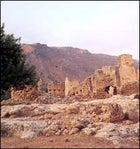 The ruins of a 250-year-old Turkish castle overlook the sea near Loutro
The ruins of a 250-year-old Turkish castle overlook the sea near Loutro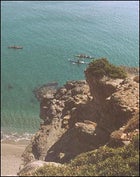 Kayakers paddle around a rocky outcropping near Sweetwater Beach.
Kayakers paddle around a rocky outcropping near Sweetwater Beach.LOUTRO
“I lived in New York City for 20 years,” said Pavlos Fradelakis, a native of Crete and the manager of the Daskalogiannis Hotel. “I came back for a visit, and I took my return ticket, tore it in two, and threw it away!” he continued, making a flamboyant ripping motion and throwing his hands in the air. We were sitting at the table closest to the water in front of his hotel, sipping Mythos, Greece’s most popular domestic beer, and watching the people go by, as he does every day of the summer.
When I rounded the corner into Loutro after the eight-mile kayak from Agia Roumeli, the view was so perfect I felt like I had stumbled upon an old Hollywood movie set. The ruins of a 250-year-old Turkish castle and a 500-year-old Venetian castle stood watch at the southern end of the small bay, and picturesque blue and white houses lined the shore in a crescent on top of the water. But Loutro is the real thing: Though it can host about 900 tourists, it is rarely full and retains the flavor of a laid-back Mediterranean fishing village. I spotted a wizened old man sitting over a large bucket of fish, baiting hooks next to a restaurant’s back door. Behind the hotels, old multi-colored boats live out their years after being retired from the seas. Besides the music and voices that drift from cafés into the night air, the town is silent. There are no cars here—only a 20-minute ferry ride or a three-mile hike from the nearest town, Hora Sfakion, can get you to Loutro. “This is the best life,” says Pavlos, who hasn’t left since he arrived for that visit 14 years ago. “It’s a quiet life and things are the same year after year.”
Practical Info: Hotel Daskalogiannis (phone: 011-30-28250-91514) rents attractive modern rooms with balconies for $47 and has the only public Internet connection in town. Hotel Sifis (phone: 011-30-28250-91337) next door rents cheaper rooms with seaside views for $29. SWEETWATER BEACH
On our way to Hora Sfakion, we docked on Sweetwater Beach, an hour-long, two-mile paddle from Loutro, to refuel with cappuccino. (This kayaking business is hard work!) The beach’s stretch of smooth white stones has several freshwater springs and acts as a camp for a motley group of nudist-hippies. As we walked along it, a Swiss man by the name of Villy came out to greet us, wearing nothing but his birthday suit and a pair of flip-flops. “Hallo!” he exclaimed. He was quite friendly and told us that he had spent 24 hours a day for the last three weeks entirely nude. Before climbing into our kayaks again, Villy showed us his camp, including the spring he used as a refrigerator, and got ready for his morning swim. As we took off, all we could see of him was his bare behind and snorkel tube poking up out of the water.
By the end of the trip, I’ve seen more than my fair share of beautiful coastline, conquered a few kayaking anxieties, and emerged stronger, tanner, and more relaxed. After I wave goodbye to my tripmates, George, the former sea captain and driver for the trip and my newfound friend, whisks me off in his car. Before we part ways, he tells me to write something good about Crete, where he has lived most of his life when not piloting ships around five continents. “I was born here, raised here, and I’m going to die here,” he says. “I hope, I hope!”
ESSENTIALS:
The Northwest Passage (800-RECREATE, ) offers eight-day sea-kayaking trips, including accommodations, most meals, equipment, and instruction along the southern coast of Crete for $2,295. Trips with a yoga instructor for daily beachside yoga sessions are also available for $2,495.
Trekking Hellas (011-30-21033-10323, ), an Athens-based organization, offers nine-day hiking trips in the gorges and along the coastline of southern Crete from $1,869 to $2,453 per person, depending on the size of the group.
For information about tourist activities and destinations throughout Greece, including Crete, contact the Greek National Tourist Organization (212-421-5777, ).
Olympic Airways (800-223-1226, ) offers direct flights from New York to Athens starting at $468, and from Athens to Iraklion for $135.
The tourism office in Hania (011-30-28210-92943) can provide information about tourist activities in the region, which includes the southwestern coast of Crete.
The Mountaineering Club of Hania (011-30-28210-44647) maintains the popular E4 Trail, which runs along the southern coast of Crete. The Club organizes occasional excursions and can provide some information about hiking and climbing in the area.


